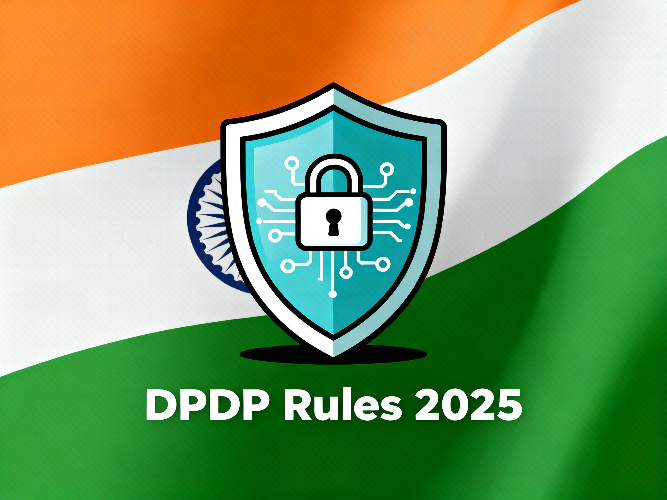India's DPDP Rules 2025: A New Era of Privacy and Data Trust
On November 14th, 2025, the Government of India notified the Digital Personal Data Protection (DPDP) Rules, establishing a modern framework for personal data protection. The DPDP Rules bring a rights-based, consent-driven, and security-focused approach—moving India closer to international privacy standards like GDPR, and offering both businesses and individuals greater confidence in digital interactions.
What Do the DPDP Rules Mean for Organizations?
Whether you're a startup, an MSME, or a large enterprise, the DPDP Rules require significant changes to how personal data is collected, used, and protected. Quick action will reduce your compliance risk and build customer trust.
Assess Current Readiness
1: Run an enterprise-wide data mapping exercise to catalog every piece of personal data you store, process, or share, including its source and destination.
- Example: Map out customer, employee, and vendor data across databases, cloud servers, spreadsheets, and paper records.
- Review your processes against DPDP's requirements around consent, notices, retention, and breach reporting to find compliance gaps.
- Audit current consent mechanisms and third-party data flows; document where consent is taken and how data moves to business partners.
Redesign Data Architecture
1: Centralize data management systems for better control and easy tracing of stored personal data.
- Example: Migrate scattered records into a secure, unified system protected by encryption and strong access controls.
- Limit stored personal data to only what's necessary for the declared purpose, and regularly purge redundant data.
- Introduce encryption, anonymization, and tokenization to minimize impact in case of a breach.
Strengthen Consent and User Rights Management
1: Build user-friendly dashboards or portals letting individuals check where their data is used, change preferences, or withdraw consent any time.
- Example: Add a “Privacy Center” to your website and mobile app for easy user management.
- Improve consent notices by making them simple, specific, and available in multiple Indian languages.
- Automate workflows so that user data requests (access, correction, deletion) are processed efficiently and within statutory deadlines.
Adopt Privacy-by-Design Frameworks
- Integrate privacy and security checks at every stage of new product and service development—not just as afterthoughts.
- Regularly conduct Privacy Impact Assessments whenever you launch major features, work with new vendors, or process sensitive categories of data.
- Appoint a Data Protection Officer (DPO) to ensure operational compliance, serve as a user contact, and interface with the Data Protection Board.
Train and Engage Teams
- Make data protection part of every employee's training—frontline staff, developers, HR, and marketing teams all need regular workshops on privacy best practices.
- Define and rehearse internal incident response plans: who acts, how quickly, and how breach notifications are managed.
- Foster a culture of privacy-first thinking by celebrating compliance successes and making data protection goals part of staff reviews.
Continuous Monitoring and Auditing
- Schedule independent, annual audits to ensure your data protection practices stay up-to-date and resilient to new risks.
- Keep records of consent, user requests, breach reports, and data transfers for regulatory review and future reference.
- Monitor regulatory updates and best practices—DPDP compliance evolves and so should your response.
Your DPDP Compliance Cheat Sheet
| Step | What to Do | Why it Matters |
|---|---|---|
| One Data Mapping: | Identify all places data is stored and shared | Uncovers hidden risks |
| Consent Review | Make notices clear and user-friendly | Meets transparency mandate |
| Centralized Architecture | Secure and consolidate personal data | Easier oversight, reduced leaks |
| User Rights Mechanisms | Enable requests and consent withdrawal | Builds trust, fulfills rights |
| Training & Auditing | Regular staff sessions and independent assessments | Prevents accidental breaches |
| Regulatory Monitoring | Track guidance and sector rules | Ensures ongoing compliance |
Frequently Asked Questions
Q: Who must comply with the DPDP Rules 2025?
Any organization processing the personal data of individuals in India, whether located domestically or overseas, will need to comply.
Q: What happens if my organization doesn't comply?
Penalties can go up to ₹250 crore (about US$28 million) per breach, depending on severity. Regulators may also require remedial actions and public notifications for breaches.
Q: Are there sector-specific requirements?
Yes, coordination with sector regulators like RBI and IRDAI is underway, and sectoral harmonization may evolve further. Stay alert to specific mandates in finance, telecom, insurance, and health.
Q: How quickly must we act?
The DPDP Rules have an eighteen-month phased compliance timeline for most provisions, but some foundational requirements are effective immediately. Use the time to prepare thoroughly, conduct gap assessments, and prioritize changes.
Q: What is a Consent Manager and do we need one?
Consent Managers are required for certain operations—they must be registered in India and serve as the interoperable point of coordination for user permissions.
Conclusion
The DPDP Rules 2025 are more than regulatory requirements—they're an opportunity for Indian businesses to demonstrate their commitment to privacy, earn user trust, and stay competitive. Organizations tackling compliance early will benefit not only from risk mitigation, but also from stronger reputations and easier data flows with global partners. Start mapping your data, engage your teams, and put privacy first to lead in India's new digital era. Contact us for a free one hour consultation

